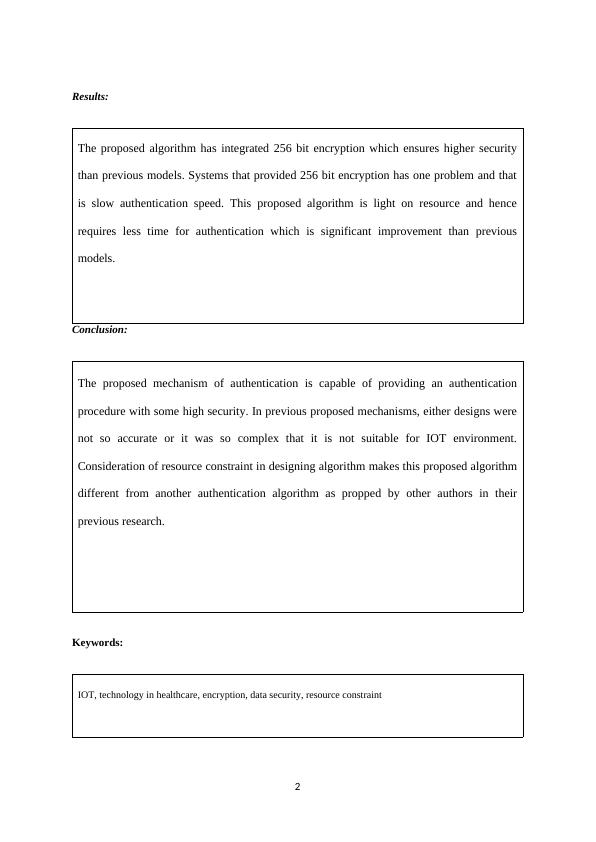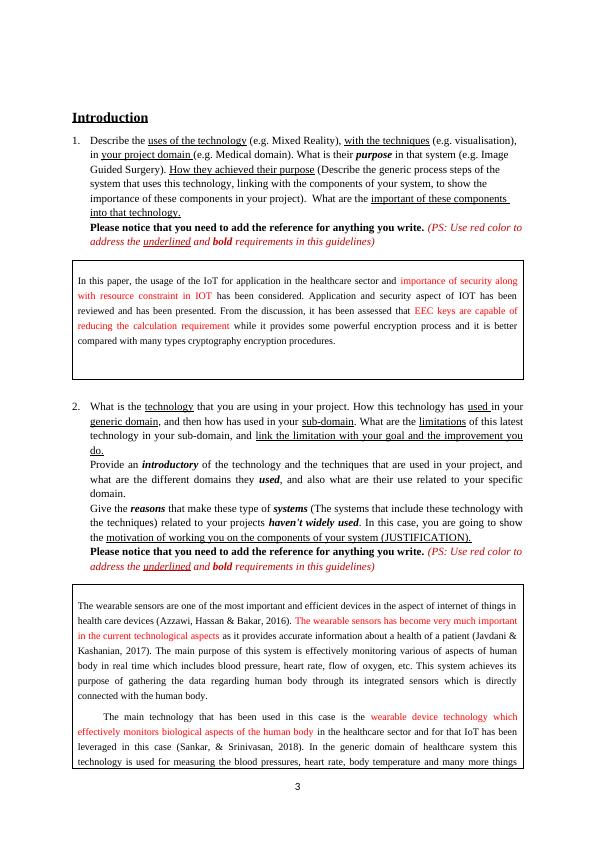Internet of Things for Smart Healthcare: Technologies, Challenges, and Opportunities
Added on 2023-04-25
10 Pages3252 Words226 Views
Internet of Things for Smart Healthcare:
Technologies, Challenges, and Opportunities
Abstract
Background and Aim:
In the current context the Internet of Things has become a very important domain where
the sensors and the embedded systems are capable of connect to each other and are also
capable of exchanging data among them. The IoT devices has gained so much importance
in the last few decades as this has provided many advantages to most of the industries and
sectors which includes the healthcare sector also. The data of the IoT is very much critical
so it must be ensured that the data are always secured from external threats and hackers.
Thus in this aspects the security constrains are very much important to keep the data of IoT
safe from the hackers and the intruders. The nature of the IoT devices as a resource
requires authentication process for the data retrieval and this process of authentication does
not requires a high computing power. Thus getting brief aspects of the IoT devices in the
paper a brief discussion has been done on the usage of IoT in the healthcare sector. Here a
brief discussion has been done on the IoT and its importance regarding the development of
the wearable devices that can track the health regarding aspects of the human body.
Methodology:
Also, in the aspects of IoT in the healthcare industry a novel authentication process has
been proposed for the IoT devices. It has been assessed that the proposed architecture is
capable of providing a secure and a structure which is very much important for the
healthcare sectors. In this aspects the CoAP protocol has been dominated by the ECC
algorithm, thus CoAP has been used in this case.
1
Technologies, Challenges, and Opportunities
Abstract
Background and Aim:
In the current context the Internet of Things has become a very important domain where
the sensors and the embedded systems are capable of connect to each other and are also
capable of exchanging data among them. The IoT devices has gained so much importance
in the last few decades as this has provided many advantages to most of the industries and
sectors which includes the healthcare sector also. The data of the IoT is very much critical
so it must be ensured that the data are always secured from external threats and hackers.
Thus in this aspects the security constrains are very much important to keep the data of IoT
safe from the hackers and the intruders. The nature of the IoT devices as a resource
requires authentication process for the data retrieval and this process of authentication does
not requires a high computing power. Thus getting brief aspects of the IoT devices in the
paper a brief discussion has been done on the usage of IoT in the healthcare sector. Here a
brief discussion has been done on the IoT and its importance regarding the development of
the wearable devices that can track the health regarding aspects of the human body.
Methodology:
Also, in the aspects of IoT in the healthcare industry a novel authentication process has
been proposed for the IoT devices. It has been assessed that the proposed architecture is
capable of providing a secure and a structure which is very much important for the
healthcare sectors. In this aspects the CoAP protocol has been dominated by the ECC
algorithm, thus CoAP has been used in this case.
1

Results:
The proposed algorithm has integrated 256 bit encryption which ensures higher security
than previous models. Systems that provided 256 bit encryption has one problem and that
is slow authentication speed. This proposed algorithm is light on resource and hence
requires less time for authentication which is significant improvement than previous
models.
Conclusion:
The proposed mechanism of authentication is capable of providing an authentication
procedure with some high security. In previous proposed mechanisms, either designs were
not so accurate or it was so complex that it is not suitable for IOT environment.
Consideration of resource constraint in designing algorithm makes this proposed algorithm
different from another authentication algorithm as propped by other authors in their
previous research.
Keywords:
IOT, technology in healthcare, encryption, data security, resource constraint
2
The proposed algorithm has integrated 256 bit encryption which ensures higher security
than previous models. Systems that provided 256 bit encryption has one problem and that
is slow authentication speed. This proposed algorithm is light on resource and hence
requires less time for authentication which is significant improvement than previous
models.
Conclusion:
The proposed mechanism of authentication is capable of providing an authentication
procedure with some high security. In previous proposed mechanisms, either designs were
not so accurate or it was so complex that it is not suitable for IOT environment.
Consideration of resource constraint in designing algorithm makes this proposed algorithm
different from another authentication algorithm as propped by other authors in their
previous research.
Keywords:
IOT, technology in healthcare, encryption, data security, resource constraint
2

Introduction
1. Describe the uses of the technology (e.g. Mixed Reality), with the techniques (e.g. visualisation),
in your project domain (e.g. Medical domain). What is their purpose in that system (e.g. Image
Guided Surgery). How they achieved their purpose (Describe the generic process steps of the
system that uses this technology, linking with the components of your system, to show the
importance of these components in your project). What are the important of these components
into that technology.
Please notice that you need to add the reference for anything you write. (PS: Use red color to
address the underlined and bold requirements in this guidelines)
In this paper, the usage of the IoT for application in the healthcare sector and importance of security along
with resource constraint in IOT has been considered. Application and security aspect of IOT has been
reviewed and has been presented. From the discussion, it has been assessed that EEC keys are capable of
reducing the calculation requirement while it provides some powerful encryption process and it is better
compared with many types cryptography encryption procedures.
2. What is the technology that you are using in your project. How this technology has used in your
generic domain, and then how has used in your sub-domain. What are the limitations of this latest
technology in your sub-domain, and link the limitation with your goal and the improvement you
do.
Provide an introductory of the technology and the techniques that are used in your project, and
what are the different domains they used, and also what are their use related to your specific
domain.
Give the reasons that make these type of systems (The systems that include these technology with
the techniques) related to your projects haven't widely used. In this case, you are going to show
the motivation of working you on the components of your system (JUSTIFICATION).
Please notice that you need to add the reference for anything you write. (PS: Use red color to
address the underlined and bold requirements in this guidelines)
The wearable sensors are one of the most important and efficient devices in the aspect of internet of things in
health care devices (Azzawi, Hassan & Bakar, 2016). The wearable sensors has become very much important
in the current technological aspects as it provides accurate information about a health of a patient (Javdani &
Kashanian, 2017). The main purpose of this system is effectively monitoring various of aspects of human
body in real time which includes blood pressure, heart rate, flow of oxygen, etc. This system achieves its
purpose of gathering the data regarding human body through its integrated sensors which is directly
connected with the human body.
The main technology that has been used in this case is the wearable device technology which
effectively monitors biological aspects of the human body in the healthcare sector and for that IoT has been
leveraged in this case (Sankar, & Srinivasan, 2018). In the generic domain of healthcare system this
technology is used for measuring the blood pressures, heart rate, body temperature and many more things
3
1. Describe the uses of the technology (e.g. Mixed Reality), with the techniques (e.g. visualisation),
in your project domain (e.g. Medical domain). What is their purpose in that system (e.g. Image
Guided Surgery). How they achieved their purpose (Describe the generic process steps of the
system that uses this technology, linking with the components of your system, to show the
importance of these components in your project). What are the important of these components
into that technology.
Please notice that you need to add the reference for anything you write. (PS: Use red color to
address the underlined and bold requirements in this guidelines)
In this paper, the usage of the IoT for application in the healthcare sector and importance of security along
with resource constraint in IOT has been considered. Application and security aspect of IOT has been
reviewed and has been presented. From the discussion, it has been assessed that EEC keys are capable of
reducing the calculation requirement while it provides some powerful encryption process and it is better
compared with many types cryptography encryption procedures.
2. What is the technology that you are using in your project. How this technology has used in your
generic domain, and then how has used in your sub-domain. What are the limitations of this latest
technology in your sub-domain, and link the limitation with your goal and the improvement you
do.
Provide an introductory of the technology and the techniques that are used in your project, and
what are the different domains they used, and also what are their use related to your specific
domain.
Give the reasons that make these type of systems (The systems that include these technology with
the techniques) related to your projects haven't widely used. In this case, you are going to show
the motivation of working you on the components of your system (JUSTIFICATION).
Please notice that you need to add the reference for anything you write. (PS: Use red color to
address the underlined and bold requirements in this guidelines)
The wearable sensors are one of the most important and efficient devices in the aspect of internet of things in
health care devices (Azzawi, Hassan & Bakar, 2016). The wearable sensors has become very much important
in the current technological aspects as it provides accurate information about a health of a patient (Javdani &
Kashanian, 2017). The main purpose of this system is effectively monitoring various of aspects of human
body in real time which includes blood pressure, heart rate, flow of oxygen, etc. This system achieves its
purpose of gathering the data regarding human body through its integrated sensors which is directly
connected with the human body.
The main technology that has been used in this case is the wearable device technology which
effectively monitors biological aspects of the human body in the healthcare sector and for that IoT has been
leveraged in this case (Sankar, & Srinivasan, 2018). In the generic domain of healthcare system this
technology is used for measuring the blood pressures, heart rate, body temperature and many more things
3

End of preview
Want to access all the pages? Upload your documents or become a member.
Related Documents
IoT in Healthcare: Securing Data and Enhancing Authentication for Wearable Deviceslg...
|29
|9374
|104
Implementation of IoT in Healthcare Systemlg...
|8
|5897
|336
(PDF) Security and privacy issues in IoTlg...
|3
|413
|58
WiMAX Networks Security Reportlg...
|3
|1235
|48
Wireless Technology Assignmentlg...
|19
|1711
|113
Wireless Networking Concept | Assignmentlg...
|7
|1457
|44
